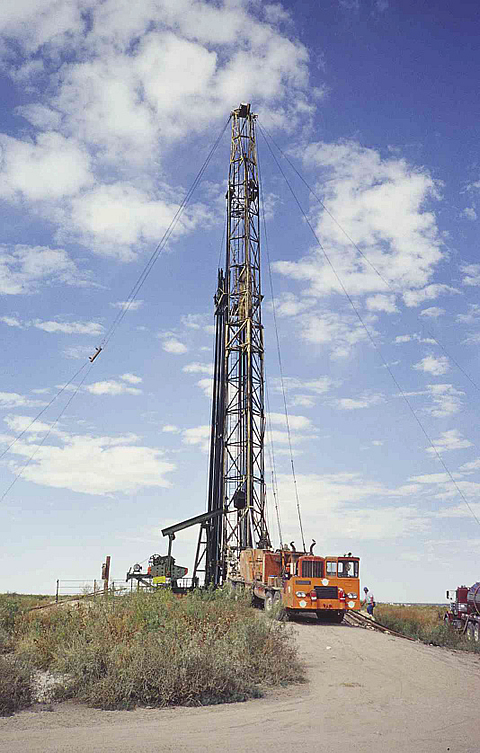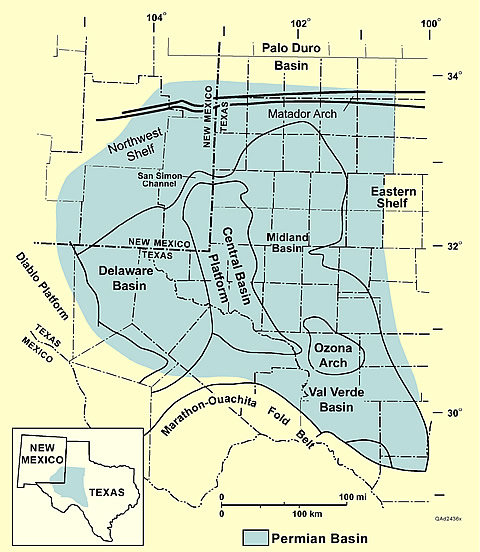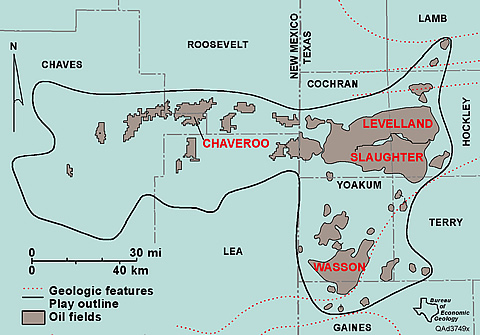The Permian Basin has produced oil for more than 80 years, and it is still one of the largest petroleum-producing basins in the U.S. In 2002, it accounted for 17% of the total U.S. oil production, and it contains an estimated 22% of the U.S. proved oil reserves. Moreover, this region has the biggest potential for additional oil production in the country, containing 29% of estimated future oil reserve growth. Because of the substantial amount of oil remaining in the basin, a new oil-play portfolio was developed.
Project Results
A play analysis digital portfolio of the oil reservoirs in the Permian Basin has been developed.
Benefits
The Digital Portfolio updates and expands the information in the pioneering volume Atlas of Major Texas Oil Reservoirs (Galloway and others, 1983), considered by many the "bible" of Texas petroleum geology. The 1983 Atlas included only reservoirs in the Texas part of the Permian Basin that produced more than 10 MMbbl of oil. Increasing the Portfolio to include the New Mexico portion of the basin and including reservoirs with production of 1 MMbbl will make the data useful to a much broader audience. Placing all the data on a CD-ROM makes it easy for independents to manipulate and incorporate information into their work. The Permian Basin contains 29% of the estimated future oil reserve growth for the U. S., which makes the 1,339 reservoirs identified in Texas and New Mexico important targets for independent operators. Release of the Play Analysis and Digital Portfolio of Major Oil Reservoirs in the Permian Basin will assist independents to develop these reservoirs.
Project Summary
- Analysis of all plays having cumulative production >1 MMbbl were included.
- Reservoir characterization studies of key reservoirs from three of the largest or most active plays in the Permian Basin were conducted
- Kelly-Snyder (SACROC Unit) in the Pennsylvanian and Lower Permian Horseshoe Atoll Carbonate play
- Fullerton in the Leonardian Restricted Platform Carbonate play
- Barnhart in the Ellenburger Dolomitized Ramp Carbonate play.
- Geologic heterogeneity in these reservoirs was investigated to better understand production constraints that would apply to all reservoirs in that play.
- Technologies for further economically viable exploitation were investigated for each play.
- Information on improved practices in reservoir development was incorporated into the portfolio.
- Individual play maps within the portfolio are linked to a database listing cumulative production and other reservoir information.
- The Permian Basin is a mature oil province and oil production has declined over the past 30 years, but an estimated 17.6 MMbbl of recoverable reserves remain.
- Peak production for the Permian Basin was 665 MMbbl/year in the early 1970s.
- By 2000 annual oil production had declined to 301.4 MMbbl.
- The 29 MMbbl of oil produced to date represents only 27% of OOIP.
- The Permian Basin Digital Portfolio is designed to encourage use of preferred management practices in mature Permian Basin oil fields.
- Preferred management practices can have a substantial impact on domestic production because of the large remaining oil resource.
The portfolio defines 32 oil plays in the Permian Basin and assigns all significant-sized reservoirs that had cumulative production of >1 MMbbl through 2000 to a play. Each of the 1,339 significant-sized reservoirs was mapped in a Geographic Information System (GIS). The portfolio contains a summary description of each play, including illustrations of key reservoir characteristics, reservoir data tables and development practices. Summaries of successful reservoir-development practices used in these plays will aid in future production in this mature basin, which will most likely come from improved recovery from existing fields.
GIS maps of each play show play outlines and reservoir locations. Associated reservoir information within linked data tables includes Texas Railroad Commission reservoir number and district, official field and reservoir name, year reservoir was discovered, depth to top of the reservoir, oil production in 2000, and cumulative oil production through 2000. Play boundaries include areas where fields in that play occur but are <1 MMbbl of cumulative production.
Cumulative Permian Basin production through 2000 from these significant-sized reservoirs was 28.9 Bbbl. The top four plays in cumulative production are the Northwest Shelf San Andres Platform Carbonate play (3.79 Bbbl), the Leonard Restricted Platform Carbonate play (3.50 Bbbl), the Pennsylvanian and Lower Permian Horseshoe Atoll Carbonate play (2.70 Bbbl), and the San Andres Platform Carbonate play (2.15 Bbbl).






